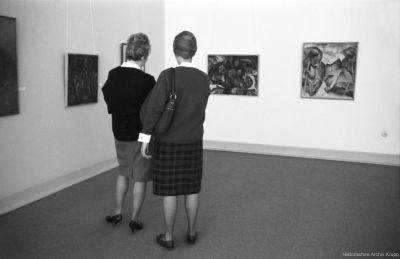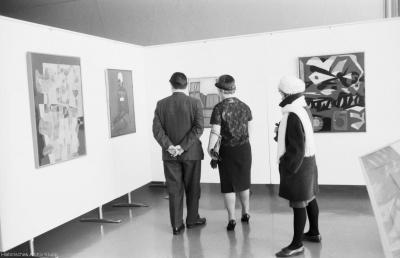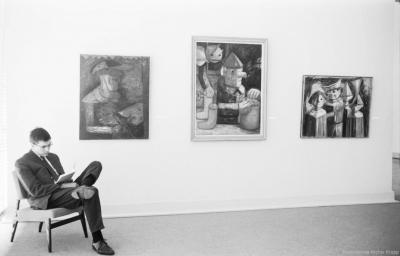Polnische Malerei vom Ausgang des 19. Jahrhunderts bis zur Gegenwart.

DIPLOMATIC PREHISTORY
In 1960 the framework conditions for cultural contacts between both countries were simultaneously favourable and unfavourable. On the one hand attempts to build closer political connections with Poland during the Adenauer era were full of cul-de-sacs, missed opportunities and resentment on both sides; the Hallstein Doctrine and the refusal to recognise the Oder Neisse border worked against the adoption of diplomatic relationships and were scarcely suited to improve what where anyway deeply strained relationships. On the other hand the quasi-diplomatic missions to Poland by Berthold Beitz, and Gerhard Schröder’s (CDU) appointment to the foreign office after the elections in autumn 1961 marked the start of a “policy of small steps” leading to the normalisation of relationships. Then again, thanks to the post-Stalinist era in the second half of the 1950s, the arts in Poland began to flourish in a lively, multifarious and highly “Western” manner that nourished sympathy and curiosity amongst the general public in West Germany, even after Poland’s cultural policies turned frostier a few years later. Poland “is all the rage here” wrote an amazed Stanisław Lorentz on a visit to West Germany in February 1963 (Lorentz report, AMNW). And in the end cultural relationships profited precisely from the difficult political relationships because the latter encouraged many individuals in West Germany to increase their efforts to improve matters between the two countries.
The fact that cultural rapprochement could serve as a pacemaker for political rapprochement was keenly invoked at the time: indeed it was even a part of the official agenda in Bonn for a brief period in 1961. Alongside an economic agreement and the exchange of consulates, a cultural agreement was intended to pave the way for the resumption of diplomatic relationships. Accompanied by Hundhausen, Beitz put forward these proposals on behalf of Adenauer to Poland’s Prime Minister Józef Cyrankiewicz on 23rd January 1961 (documented in: Mieczysław Tomala, Deutschland – von Polen gesehen. Zu den deutsch-polnischen Beziehungen 1945–1990, Marburg 2000, 199–209). Nonetheless the exploratory discussions failed because of the mistrust amongst Polish government officials who suspected that these were no more than stalling tactics on behalf of the West German government. The Poles refused to be bought off with substitute proposals and it was not until 1963, after many delays, that the two countries were able to sign an economic agreement.
With regard to the Folkwang exhibition the political fiasco in January 1961 is all the more remarkable because it provides the perfect example of the frequent proximity of failed official contacts and successful informal contacts between Poland and West Germany. The Folkwang exhibition was agreed at precisely the same time and with precisely the same personal constellation (Beitz, Hundhausen, Cyrankiewicz). It is very possible that precisely the failure of official consultations between the participants strengthened their personal convictions. Whatever the case, Beitz’s and Hundhausen’s close relationships with the Polish government and the preparations for the Folkwang exhibition did no harm Beitz’s reputation as an amateur diplomat. Following several discussions between Beitz, Hundhausen, Cyrankiewicz and the Polish cultural minister Tadeusz Galiński, Cyrankiewicz gave his official consent in summer 1961: and on 12th August Hundhausen and Beitz were able to announce triumphantly that “the exhibition in the Folkwang Museum is guaranteed in every aspect.” (HAK, WA 125/2)
Preparations were helped by several favourable circumstances. On the one hand Beitz and Hundhausen, who had taken charge of the planning, were extremely active, influential personalities with a good network of communications; and this was further helped by the fact that they had good business contacts with Poland. On the other hand, this was not the first cooperative project between the Krupp firm and the National Museum in Warsaw. Its director Stanisław Lorentz had already agreed to loan works to major exhibitions presented in the Villa Hügel (here we are referring to the exhibitions of Egyptian and Persian art in summer 1961 and spring 1962 respectively), whose managing director was Hundhausen. In addition Beitz and Hundhausen could fall back on firmly established partnerships with the city of Essen and the Folkwang Museum. And last not least there was a clear change in atmosphere in the Foreign Office. Up until then it had been notorious for its blockade policy but, at the latest, from the time Schröder took office in autumn 1961 a more flexible attitude towards the eastern bloc states began to prevail. Furthermore, at least at an informal level, the foreign office was increasingly active in the area of Polish/West German cultural exchanges. Officials there realised “that cultural exchanges could be extremely important, when political and business relationships were not functioning as well as they should”, as formulated by the head of the cultural department of the Foreign Office, Dieter Sattler (according to the Krupp representative Günter Lück to Beitz, 6.2.1963, AMNW). There had been hints of this as early as summer 1961 when the Foreign Office cultural department announced that it had “no reservations whatsoever” against the planned exhibition and that it was “at the present time […] even highly desirable” (Hundhausen to Beitz, 20.6.1961, AMF). However the situation remained intricate, as illustrated by an anecdote related by Hundhausen about a visit to Sattler with Lorentz in February 1963: “Herr Lorentz and Herr Sattler had a detailed discussion, the contents of which were clearly of great satisfaction to Herr Sattler, for his final remark was: ‘When I think about it we shouldn’t really be talking to each other at all’”. (Hundhausen to Beitz, 14.2.1963, AMNW)




